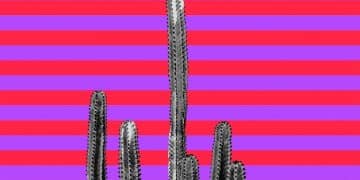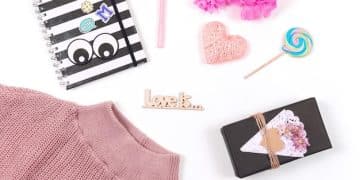Gen Z Fashion Trends: What’s Hot in the US Right Now?
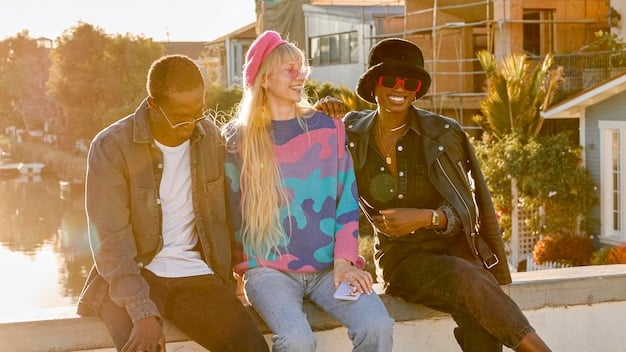
Gen Z’s influence is reshaping the fashion landscape in the US, driving trends like vintage revival, sustainable fashion, gender-neutral clothing, and tech-integrated apparel, reflecting their values and digital-native lifestyles.
Gen Z’s influence: What fashion trends are they driving in the US right now? This question is on the minds of designers, retailers, and fashion enthusiasts alike. Born between the late 1990s and early 2010s, Gen Z is a generation that’s digitally native, socially conscious, and fiercely independent. Their distinctive approach to style and self-expression is rapidly changing the fashion landscape, pushing boundaries, and redefining what’s considered trendy.
Decoding Gen Z’s Fashion Influence
Gen Z wields immense power over current fashion trends; their preferences and values are reshaping the industry. Gen Z’s influence extends beyond simply adopting styles, and it’s about expressing individuality, embracing sustainability, and pushing for greater inclusivity.
By understanding how they consume fashion and how they are influenced, we can see a reflection of a future defined by personalized style and the pursuit of a fair fashion industry for the world.
The Digital Native Effect
Growing up in the digital age has provided Gen Z with unprecedented access to fashion inspiration, trends, and shopping experiences. Social media platforms like TikTok, Instagram, and Pinterest are their primary sources of inspiration, where they discover new designers, brands, and styles.
- Social Media Consumption: Gen Z gets trends from social feeds, not just magazines.
- Influencer Power: They trust influencers who share their values and aesthetics.
- Online Shopping Dominance: E-commerce is their natural habitat for fashion.
Gen Z is always connected, which makes it easier for them to shape fashion trends and to be the first to have access to limited products from online shopping. This will lead to a more democratic and accessible fashion world, with less gatekeeping of styles and a more collaborative and friendly approach to design. By connecting with like-minded shoppers from all over the world, Gen Z can find their space and develop a unique personal brand.
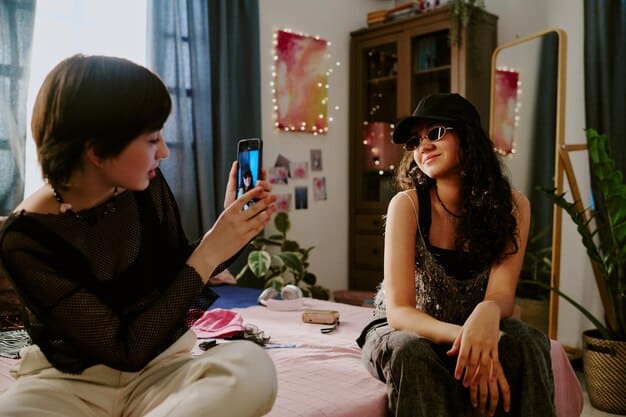
The Rise of Sustainable Fashion
One of the most significant Gen Z’s influence on fashion is their strong commitment to sustainability and ethical practices. They are deeply concerned about the environmental and social impact of the fashion industry and actively seek out brands and products that align with their values.
They are more likely to support brands that prioritize transparency, fair labor practices, and eco-friendly materials.
Secondhand and Vintage
Thrifting and vintage shopping have become incredibly popular among Gen Z, driven by a desire to reduce waste and find unique, one-of-a-kind pieces. Online platforms like Depop, Poshmark, and ThredUp have made it easier.
Upcycling and DIY
Many Gen Z fashion enthusiasts are taking matters into their own hands by upcycling old clothes into new creations or creating their own unique pieces from scratch. This DIY approach aligns with Gen Z’s desire for self-expression and sustainability
- Ethical Brands: Supporting brands with fair labor and eco-friendly practices.
- Sustainable Materials: Favoring organic cotton, recycled fabrics, and innovative textiles.
- Minimalist Wardrobes: Embracing quality over quantity for a lasting impact.
Gen Z is committed to driving positive change within the fashion industry. By choosing more sustainable options and advocating for greater transparency, they are creating a ripple effect that is pushing brands to adopt more responsible practices. Fashion brands that are aware of these trends usually try to stay updated with the newest solutions in environmental responsibility and social justice. Gen Z consumers are using their purchasing power to support brands and promote a more ethical and environmentally responsible fashion sphere.
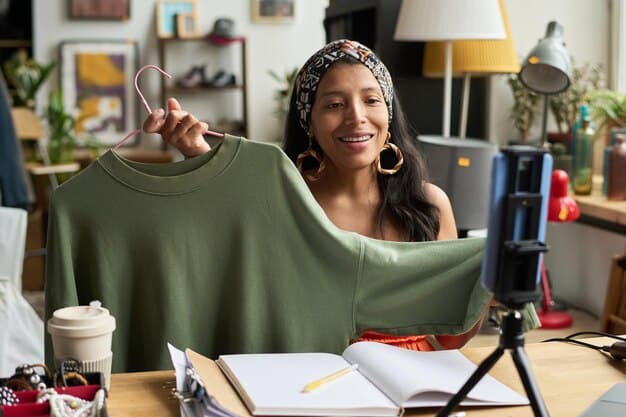
Gender-Neutral and Inclusive Fashion
Gen Z is challenging traditional gender norms and embracing inclusivity in fashion. They are pushing for more gender-neutral clothing options and celebrating diverse body types, ethnicities, and identities. Gen Z’s influence is all about expressing people as they see themselves, no matter their gender or background.
This commitment to inclusivity is a breath of fresh air in an industry that has historically been criticized for its narrow beauty standards and limited representation.
Blurring Gender Lines
Gender-neutral clothing, also known as unisex or gender-free fashion, is becoming increasingly popular among Gen Z. This trend involves clothing that is designed to be worn by anyone, regardless of their gender identity.
Celebrating Body Positivity
Gen Z is also challenging traditional beauty standards and promoting body positivity. The generation welcomes brands that are inclusive of different body types and sizes, and they appreciate campaigns that feature models with diverse backgrounds.
Gen Z is fostering a more inclusive and accepting fashion industry. Fashion brands that want to have loyal consumers from this demographic need to align their practices to the Gen Z ideology, celebrating diversity in all forms.
Tech-Integrated Fashion
As digital natives, Gen Z is naturally drawn to fashion that incorporates technology. Gen Z’s influence can be seen on tech-integrated accessories, smart clothing, and Virtual fashion and augmented reality experiences. Tech and fashion can create a more integrated and experiential approach of consumption, therefore increasing sustainability and personalization.
The integration of technology into fashion is not just about creating novel experiences but about enhancing functionality, personalization, and sustainability.
Wearable Technology
Wearable technology, such as smartwatches, fitness trackers, and connected clothing, has become increasingly popular among Gen Z. These devices not only enhance functionality, like monitoring health, or making digital payments, but are also fashion statements.
Virtual Fashion
Virtual fashion is a growing trend that involves creating digital clothing and accessories that can be worn by avatars or superimposed onto real-life images and videos. This allows Gen Z to express their creativity, experiment with different styles, and participate in the fashion world without physically purchasing clothing.
- Customization: Using technology to personalize clothing and accessories.
- Experiential Retail: Blending online and offline experiences with AR and VR.
- Sustainable Production: Designing clothes virtually to reduce environmental impact.
Gen Z is at the forefront of integrating technology into fashion, driving innovation and creating new experiences. By embracing these trends, manufacturers respond to the latest market demands. Some brands even use new strategies to offer consumers a more creative, custom and immersive approach, while reducing waste.
The Resurgence of Y2K Fashion
Nostalgia plays a significant role in Gen Z fashion trends, and one of the most prominent examples of this is the resurgence of Y2K fashion. Inspired by the late 1990s and early 2000s, this trend is characterized by its playful, vibrant, and often nostalgic aesthetic. Gen Z’s influence is undeniable in the popularization of Y2K fashion, using their creative flair to revive and remix historical fashion codes.
This nostalgic trend is a reflection of Gen Z’s love for all things vintage and their desire to put a unique spin on past styles.
Mini Skirts and Crop Tops
Mini skirts and crop tops are essential components of the modern Y2K trend when adopted by generation Z. The garments can be matched with other current clothing or garments from the same era to create a fresh appearance.
Platform Shoes and Chunky Sneakers
Platform shoes and chunky sneakers are footwear staples of Y2K fashion, adding height and making a statement. The shoes can be paired with many different outfits, from casual jeans to dressy skirts and dresses, adding a retro touch to any look.
Gen Z loves to mix and match Y2K pieces with current trends, creating unique and personalized outfits. They are unafraid to experiment with different styles and aesthetics, resulting in a fashion landscape that is constantly evolving. By experimenting and borrowing elements and styles from past decades, Generation Z gives them a new context and meaning that resonates with their identity.
Redefining Streetwear
Streetwear, which has its roots in skate and hip-hop culture, has evolved into a dominant force in the fashion industry due to Gen Z’s influence. Generation Z has embraced streetwear and given it their own unique twist, blending it with other trends and styles. The generation is known for their creative and experimental approach to fashion.
This new take on streetwear is a reflection of Gen Z’s diverse interests and their desire to express themselves authentically.
Comfort and Functionality
Gen Z prioritizes comfort and functionality in their clothing choices, and this is evident in their approach to streetwear. They favor oversized hoodies, baggy pants, and comfortable sneakers that can be easily dressed up or down.
Bold Colors and Graphics
While comfort and functionality are key, Gen Z also loves to make a statement with their streetwear. They incorporate bold colors, graphics, and patterns into their outfits, adding a touch of personality and individuality.
Gen Z likes to match streetwear with Y2K pieces or even high fashion items, creating unexpected and fashion-forward looks. Additionally, this generation brings new interpretations and cultural references, remixing styles and meanings to reflect their values and attitudes.
| Key Trend | Brief Description |
|---|---|
| ♻️ Sustainable Fashion | Eco-friendly materials, thrifted clothes, and ethical brands. |
| 👕 Gender-Neutral | Clothing designed to be worn by anyone, regardless of gender. |
| 🌐 Tech-Integrated | Smart clothing, wearable gadgets, and virtual experiences. |
| ✨ Y2K Revival | Nostalgic fashion from the late 90s and early 2000s. |
Frequently Asked Questions
▼
Gen Z fashion is defined by its diversity and adaptability. It’s influenced by social media, sustainability, and a rejection of traditional style norms, featuring everything from vintage to tech-integrated clothing.
▼
Social media platforms like TikTok and Instagram serve as major sources of inspiration for Gen Z. They discover new styles, brands, and influencers, creating trends via rapid online sharing and adoption.
▼
Gen Z is highly aware of fashion’s environmental impact. They favor sustainable practices such as secondhand shopping, upcycling, and supporting eco-conscious brands, reflecting their values.
▼
Technology is integrated through wearable tech, virtual fashion, and personalized shopping experiences. It offers customization and promotes more sustainable and creative consumption methods.
▼
Gen Z pushes for significant shifts in inclusivity, sustainability, and technology integration. Their preferences impact how brands market, produce, and promote clothing and accessories, reshaping industry standards.
Conclusion
Gen Z’s influence on fashion is undeniable, shaping trends from sustainable practices to gender-neutral styles and tech integrations. As they continue to drive change, expect the fashion industry to evolve even further, reflecting their values and vision for a more inclusive and creative future.



